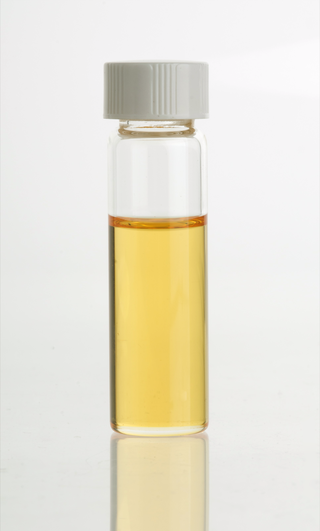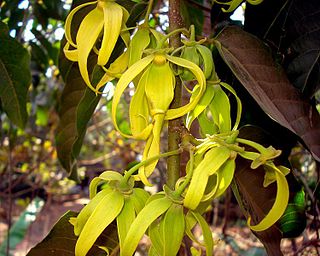Perfume is a mixture of fragrant essential oils or aroma compounds (fragrances), fixatives and solvents, usually in liquid form, used to give the human body, animals, food, objects, and living-spaces an agreeable scent. Perfumes can be defined as substances that emit and diffuse a pleasant and fragrant odor. They consist of manmade mixtures of aromatic chemicals and essential oils. The 1939 Nobel Laureate for Chemistry, Leopold Ružička stated in 1945 that "right from the earliest days of scientific chemistry up to the present time, perfumes have substantially contributed to the development of organic chemistry as regards methods, systematic classification, and theory."

Cedar oil, also known as cedarwood oil, is an essential oil derived from various types of conifers, most in the pine or cypress botanical families. It is produced from the foliage, and sometimes the wood, roots, and stumps left after logging of trees for timber. It has many uses in art, industry, and perfumery, and while the characteristics of oils derived from various species may vary, all have some degree of pesticidal effects.

An essential oil is a concentrated hydrophobic liquid containing volatile chemical compounds from plants. Essential oils are also known as volatile oils, ethereal oils, aetheroleum, or simply as the oil of the plant from which they were extracted, such as oil of clove. An essential oil is essential in the sense that it contains the essence of the plant's fragrance—the characteristic fragrance of the plant from which it is derived. The term "essential" used here does not mean indispensable or usable by the human body, as with the terms essential amino acid or essential fatty acid, which are so called because they are nutritionally required by a living organism.

Cananga odorata, known as ylang-ylang or cananga tree, is a tropical tree that is native to and originated in the Philippines and spread to Malaysia, Indonesia, New Guinea, the Solomon Islands, and Queensland, Australia. It is also native to parts of Cambodia, Thailand, India and Vietnam. It is valued for the essential oils extracted from its flowers, which has a strong floral fragrance. Ylang-ylang is one of the most extensively used natural materials in the perfume industry, earning it the name "Queen of Perfumes".

Used in perfumery and aromatherapy, absolutes are similar to essential oils. They are concentrated, highly aromatic, oily mixtures extracted from plants. Whereas essential oils are produced by distillation, boiling or pressing, absolutes are produced through solvent extraction, or more traditionally, through enfleurage.

Cannabis sativa is an annual herbaceous flowering plant. The species was first classified by Carl Linnaeus in 1753. The specific epithet sativa means 'cultivated'. Indigenous to Eastern Asia, the plant is now of cosmopolitan distribution due to widespread cultivation. It has been cultivated throughout recorded history and used as a source of industrial fiber, seed oil, food, and medicine. It is also used as a recreation drug and for religious and spiritual purposes.

An aroma compound, also known as an odorant, aroma, fragrance or flavoring, is a chemical compound that has a smell or odor. For an individual chemical or class of chemical compounds to impart a smell or fragrance, it must be sufficiently volatile for transmission via the air to the olfactory system in the upper part of the nose. As examples, various fragrant fruits have diverse aroma compounds, particularly strawberries which are commercially cultivated to have appealing aromas, and contain several hundred aroma compounds.

Rose oil is the essential oil extracted from the petals of various types of rose. Rose ottos are extracted through steam distillation, while rose absolutes are obtained through solvent extraction, the absolute being used more commonly in perfumery. The production technique originated in Greater Iran. Even with their high price and the advent of organic synthesis, rose oils are still perhaps the most widely used essential oil in perfumery.

Neroli oil is an essential oil produced from the blossom of the bitter orange tree. Its scent is sweet, honeyed and somewhat metallic with green and spicy facets. Orange blossom is also extracted from the same blossom and both extracts are extensively used in perfumery. Orange blossom can be described as smelling sweeter, warmer and more floral than neroli. The difference between how neroli and orange blossom smell and why they are referred to with different names, is a result of the process of extraction that is used to obtain the oil from the blooms. Neroli is extracted by steam distillation and orange blossom is extracted via a process of enfleurage or solvent extraction.
Aromachology is the study of the influence of odors on human behavior and to examine the relationship between feelings and emotions. Those who practice aromachology are aromachologists. Aromachologists analyze emotions such as relaxation, exhilaration, sensuality, happiness and well-being brought about by odors stimulating the olfactory pathways in the brain and, in particular, the limbic system. Different wearers are thought to have unique physiological and psychological responses to scents, especially those not manufactured synthetically but based on real scents. The word "aromachology" is derived from "aroma" and "physio-psychology", the latter being the study of aroma. This term was coined in 1989 by what is now the Sense of Smell Institute (SSI), a division of The Fragrance Foundation. The SSI defines aromachology as "a concept based on systematic, scientific data collected under controlled conditions". The term is defined as the scientifically observable influence of smell on emotions and moods. Consumers use aromachology to alleviate time pressures, for relaxation or stimulation and as a component of other activities that generate a feeling of well-being.

Myrcene, or β-myrcene, is a monoterpene. A colorless oil, it occurs widely in essential oils. It is produced mainly semi-synthetically from Myrcia, from which it gets its name. It is an intermediate in the production of several fragrances. α-Myrcene is the name for the isomer 2-methyl-6-methylene-1,7-octadiene, which has not been found in nature.

Fragrance extraction refers to the separation process of aromatic compounds from raw materials, using methods such as distillation, solvent extraction, expression, sieving, or enfleurage. The results of the extracts are either essential oils, absolutes, concretes, or butters, depending on the amount of waxes in the extracted product.

Plant oils or vegetable oils are oils derived from plant sources, as opposed to animal fats or petroleum. There are three primary types of plant oil, differing both the means of extracting the relevant parts of the plant, and in the nature of the resulting oil:
- Vegetable fats and oils were historically extracted by putting part of the plant under pressure, squeezing out the oil.
- Macerated oils consist of a base oil to which parts of plants are added.
- Essential oils are composed of volatile aromatic compounds, extracted from plants by distillation.

Cannabis flower essential oil, also known as hemp essential oil, is an essential oil obtained by steam distillation from the flowers, panicles, stem, and upper leaves of the hemp plant. Hemp essential oil is distinct from hemp seed oil and hash oil: the former is a vegetable oil that is cold-pressed from the seeds of low-THC varieties of hemp, the latter is a THC-rich extract of dried female hemp flowers (marijuana) or resin (hashish).

Eau de toilette is a lightly scented perfume. It is also referred to as aromatic waters and has a high alcohol content. It is usually applied directly to the skin after bathing or shaving. It is traditionally composed of alcohol and various volatile oils. Traditionally these products were named after a principal ingredient; some being geranium water, lavender water, lilac water, violet water, spirit of myrcia and 'eau de Bretfeld'. Because of this, eau de toilette was sometimes referred to as "toilet water".

Attar, also known as ittar, is an essential oil derived from botanical or other natural sources. Most commonly these oils are extracted via hydrodistillation or steam distillation. The Persian physician Ibn Sina was first to derive the attar of flowers from distillation. Attar can also be expressed by chemical means but generally natural perfumes which qualify as attars are distilled with water. The oils are generally distilled into a wood base such as sandalwood and then aged. The aging period can last from one to ten years depending on the botanicals used and the results desired. Technically attars are distillates of flowers, herbs, spices and other natural materials such as baked soil over sandalwood oil/liquid paraffins using hydrodistillation technique involving a still and receiving vessel. These techniques are still in use today at Kannauj in India.
Heptanal or heptanaldehyde is an alkyl aldehyde. It is a colourless liquid with a strong fruity odor, which is used as precursor to components in perfumes and lubricants.
Concrete, in perfumery, is a waxy mass obtained by solvent extraction of fresh plant material. It is usually used for the production of absolutes.

Bergamot essential oil is a cold-pressed essential oil produced by cells inside the rind of a bergamot orange fruit. It is a common flavoring and top note in perfumes. The scent of bergamot essential oil is similar to a sweet light orange peel oil with a floral note.














